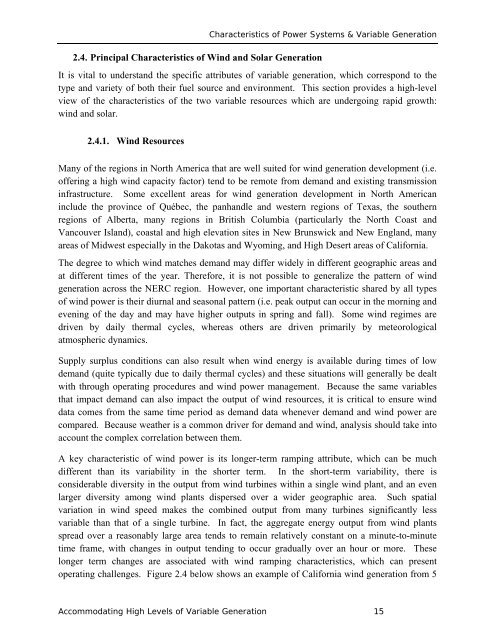Accommodating High Levels of Variable Generation - NERC
Accommodating High Levels of Variable Generation - NERC
Accommodating High Levels of Variable Generation - NERC
You also want an ePaper? Increase the reach of your titles
YUMPU automatically turns print PDFs into web optimized ePapers that Google loves.
2.4. Principal Characteristics <strong>of</strong> Wind and Solar <strong>Generation</strong><br />
Characteristics <strong>of</strong> Power Systems & <strong>Variable</strong> <strong>Generation</strong><br />
It is vital to understand the specific attributes <strong>of</strong> variable generation, which correspond to the<br />
type and variety <strong>of</strong> both their fuel source and environment. This section provides a high-level<br />
view <strong>of</strong> the characteristics <strong>of</strong> the two variable resources which are undergoing rapid growth:<br />
wind and solar.<br />
2.4.1. Wind Resources<br />
Many <strong>of</strong> the regions in North America that are well suited for wind generation development (i.e.<br />
<strong>of</strong>fering a high wind capacity factor) tend to be remote from demand and existing transmission<br />
infrastructure. Some excellent areas for wind generation development in North American<br />
include the province <strong>of</strong> Québec, the panhandle and western regions <strong>of</strong> Texas, the southern<br />
regions <strong>of</strong> Alberta, many regions in British Columbia (particularly the North Coast and<br />
Vancouver Island), coastal and high elevation sites in New Brunswick and New England, many<br />
areas <strong>of</strong> Midwest especially in the Dakotas and Wyoming, and <strong>High</strong> Desert areas <strong>of</strong> California.<br />
The degree to which wind matches demand may differ widely in different geographic areas and<br />
at different times <strong>of</strong> the year. Therefore, it is not possible to generalize the pattern <strong>of</strong> wind<br />
generation across the <strong>NERC</strong> region. However, one important characteristic shared by all types<br />
<strong>of</strong> wind power is their diurnal and seasonal pattern (i.e. peak output can occur in the morning and<br />
evening <strong>of</strong> the day and may have higher outputs in spring and fall). Some wind regimes are<br />
driven by daily thermal cycles, whereas others are driven primarily by meteorological<br />
atmospheric dynamics.<br />
Supply surplus conditions can also result when wind energy is available during times <strong>of</strong> low<br />
demand (quite typically due to daily thermal cycles) and these situations will generally be dealt<br />
with through operating procedures and wind power management. Because the same variables<br />
that impact demand can also impact the output <strong>of</strong> wind resources, it is critical to ensure wind<br />
data comes from the same time period as demand data whenever demand and wind power are<br />
compared. Because weather is a common driver for demand and wind, analysis should take into<br />
account the complex correlation between them.<br />
A key characteristic <strong>of</strong> wind power is its longer-term ramping attribute, which can be much<br />
different than its variability in the shorter term. In the short-term variability, there is<br />
considerable diversity in the output from wind turbines within a single wind plant, and an even<br />
larger diversity among wind plants dispersed over a wider geographic area. Such spatial<br />
variation in wind speed makes the combined output from many turbines significantly less<br />
variable than that <strong>of</strong> a single turbine. In fact, the aggregate energy output from wind plants<br />
spread over a reasonably large area tends to remain relatively constant on a minute-to-minute<br />
time frame, with changes in output tending to occur gradually over an hour or more. These<br />
longer term changes are associated with wind ramping characteristics, which can present<br />
operating challenges. Figure 2.4 below shows an example <strong>of</strong> California wind generation from 5<br />
<strong>Accommodating</strong> <strong>High</strong> <strong>Levels</strong> <strong>of</strong> <strong>Variable</strong> <strong>Generation</strong> 15
















